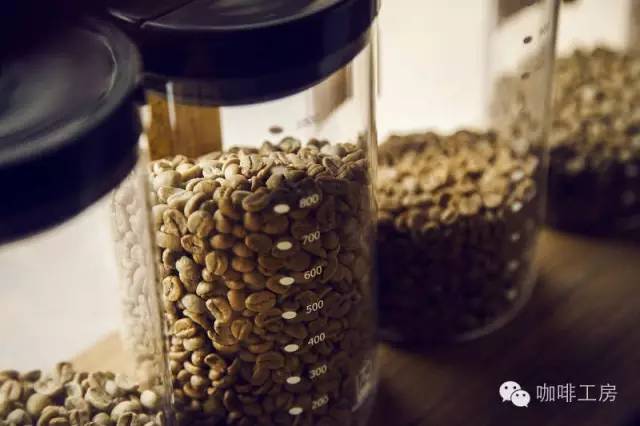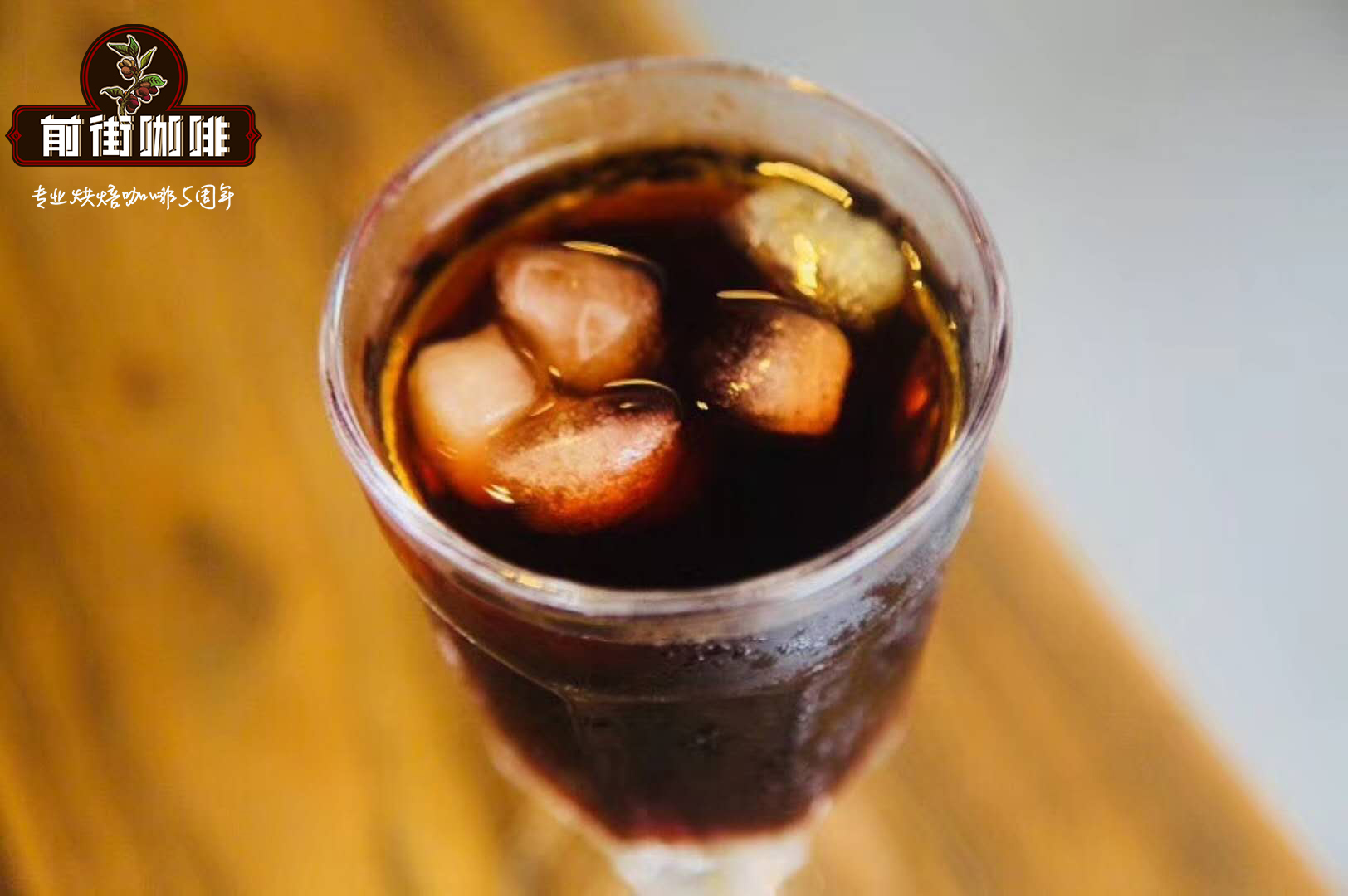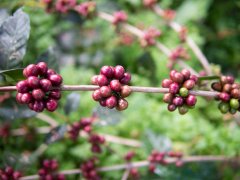What is the method of low temperature water washing and fermentation? What are the advantages of frozen raw coffee beans? How to make a living

Professional coffee knowledge exchange more coffee bean information please follow the coffee workshop (Wechat official account cafe_style)
A method of freezing Coffee Fruit at low temperature
[technical field]
The invention relates to the technical field of coffee processing, in particular to a method for freezing coffee fruit at low temperature.
[background technology]
Coffee is grown in the tropical region between 24 degrees in Beiwei and 25 degrees in Nanwei. Coffee beans are divided into two categories, Arabica and Robusta. Arabica coffee beans are produced above 800 meters above sea level, and Robbda coffee beans are produced below 800 meters above sea level. Generally speaking, they are picked once or twice a year, and one picking season lasts 3-5 months, so overall there will be 3-4 months of non-picking season, resulting in a decline in supply. For example, in the Aceh coffee producing region of Indonesia, the coffee picking season is divided into high production period (May to September) and small birth period (November to January), so coffee production almost stops from February to April.
After the coffee fruit is ripe and appears red, it is usually treated in three ways, namely, water washing, semi-washing and sun drying. The washing method is that within 1-2 days after picking, the outer peel and some pulp are washed off by manual or machine water to leave the coffee beans, and the coffee beans are soaked in water for 18-36 hours to ferment, so that the pulp falls off completely further, leaving clean coffee beans. Washed coffee beans will be exposed to the sun for 3-5 days, so that their water content is about 15%. The treatment of semi-washing omits the link of soaking and fermentation in the washing method, but it will prolong the sun exposure time for about 7-14 days. The sun drying method is more suitable for some areas where there is a lack of water resources but plenty of sunshine. After the fruit is picked, the sun will be insolated for 2 weeks to 1 month, which also makes the coffee beans reach 15% water content. After the above three steps, the shelling step is also needed, that is, the coffee bean is put into the machine to make its shell fall off.
Generally, raw beans, which are usually treated by washing, will have moderate sour taste, high alcohol thickness and moderate bitter taste, and the flavor will vary according to the local soil and climatic environment. The raw beans treated by the sun have higher sour taste, lower alcohol thickness and slightly bitter taste, and the flavor is affected by soil and climate. The treatment of raw beans by semi-washing method is both mellow and sour, with moderate bitterness.
[processing content]
The purpose of this paper is to provide a method of low temperature freezing treatment of coffee fruit in view of the shortcomings of the above methods of coffee fruit treatment, and to solve the problem of yield decline and taste deficiency caused by coffee in non-picking season.
In order to achieve the above purpose, a method of freezing coffee fruit at low temperature is designed, which includes a space with constant temperature and humidity. The specific steps of the method are as follows: after the coffee fruit is picked, it is sent into the space with constant temperature and humidity, and the fruit is placed on the rack. The rack is laid with breathable materials, and the temperature of the space with constant temperature and humidity is maintained below 4 degrees Celsius. At this temperature, the density of water reaches the highest value. Can absorb the taste and smell of the fruit in the coffee bean, at this low temperature, the water of the fruit is also constantly evaporating, but the slow process takes 2 weeks to 2 months, and then wash the fruit to remove the pulp, and then take it to the sun for 7-14 days. Reduce its water content to 15%.
The temperature in the constant temperature and humidity space is below minus 2 degrees Celsius, which makes the coffee fruit frozen, the water content of the coffee fruit is high, and its internal structure changes after freezing. At the same time, the water is slowly losing, but the slow process takes 1 to 2 months, and then the coffee beans are exposed to the sun for 2 weeks to 1 month, so that the water content of coffee beans reaches 15%.
The breathable material on the shelf is waterproof, moisture permeable, and the air permeability is at least 2250g/m2-24Hr, ensuring that the fruit can emit moisture completely without having to turn it over.
The height of the rack is 10 cm apart to keep the air flowing. The tray on each layer is composed of stainless steel strips, and the breathable material is placed on the tray.
After low temperature treatment, the average daily dehydration rate of 1 kg fruit is 1.7%. After low temperature treatment, the average daily dehydration rate is 1.7%.
About 12.3%.
After freezing treatment, the average daily dehydration rate of 1 kg fruit is 0.9%, and after freezing treatment, the average daily dehydration rate is 0.9%.
About 13.7%.
The invention takes into account that the picking of coffee beans is seasonal, uses a low temperature or freezing method to deal with the fruit, and the freshest coffee beans can be obtained even in the non-picking season, which solves the problem of insufficient supply caused by no fresh coffee production in the non-production period. the problem of supply decline, and the coffee treated by low temperature has a mellow taste, bright acidity, moderate bitterness, high sweetness and smooth taste. When raw beans are treated by freezing method, the taste of coffee beans treated at low temperature is stronger and more layered than that of coffee treated at low temperature. the coffee treated by low temperature or freezing method has good cup test experience and high score, which can be called fine coffee.
[specific implementation method]
The following is a further illustration of the invention in combination with the attached drawings, and the structure and principle of the device are very clear to people in this profession. It should be understood that the specific embodiments described herein are used only to explain the invention and are not used to define the invention.
The invention is a method for treating coffee fruit at low temperature, which must be carried out in an ad hoc / constant temperature and humidity space, and the constant temperature and humidity environment in the whole low greenhouse, the required setting standard can be achieved simply through some existing commercial refrigerators and constant humidity machines, and the low temperature treatment method can not exceed 4 degrees Celsius at most, including freezing treatment. After picking the fruit, send it to the low temperature room on the same day, put the fruit on a special rack and place the breathable material laid on the rack. Keep the temperature of the low greenhouse at 4 degrees Celsius. Because at this temperature, the density of water is the highest at 3.98 degrees, if it becomes ice, its volume will expand by about 10%. Water has the characteristic of reverse expansion between 0 °C _ 4 °C and the highest density (l.0Og/cm3) at 4 °C. When the ice is cold to 0 °C, the density decreases (0.92g/cm3), that is to say, the heat shrinks and the cold rises. The main reason is that it is determined by the arrangement of molecules. Because water molecules have strong polarity, they can be combined to form associating molecules through hydrogen bonds. Liquid water contains not only simple water molecules, but also association molecules 0120) 2 and (H20) 3. When the water does not freeze at 0 °C, most of the water molecules exist as association molecules of 0120) 3. When the temperature rises to 3.98 °C (lOlkPa), the water molecules mostly exist in the form of 20) 2 association molecules, the space occupied by the molecules is relatively reduced, and the density of water is the highest. When water forms ice, the movement of water molecules can not destroy the hydrogen bond, which plays a major role. It binds water molecules together to form a regular spatial structure, and almost all the molecules are associated together to form a huge association molecule. In ice, the arrangement of water molecules is that each oxygen atom has four hydrogen atoms as neighbors (two covalent bonds, two hydrogen bonds) in one lattice, four hydrogen atoms on the top of the regular tetrahedron. An oxygen atom is located in the center of the tetrahedron, which enlarges the gap between molecules and maintains an open structure, so that the volume of water becomes larger when it freezes. At this temperature, the density of water reaches the highest value, which helps to absorb the taste and smell of the fruit in the coffee beans. secondly, at this low temperature, the water of the fruit continues to evaporate, but the process takes about 2 weeks to 2 months. After that, the fruit is washed to remove the pulp, and then exposed to the sun for about 7-14 days, so that its water content is reduced to 15%.
The way to freeze the coffee fruit is to put the fruit in a low greenhouse of minus 2 degrees Celsius to freeze it. Because of the high water content of the fruit, its internal structure changes after freezing, at the same time, its water is slowly losing, but the process takes about 1 to 2 months, and then it is exposed to the sun for 2 weeks to 1 month. it also makes the coffee beans have a water content of 15%.
The height of the rack should be 10 cm apart in order to maintain the mobility of the air. Each layer of the tray is composed of stainless steel strips, and the special breathable material is placed on the tray. The total height of the shelf is 135 cm, the total width is 60 cm, and the total depth is 80 cm. Each shelf can hold about 10 kilograms of fruit on each floor, so each shelf can hold a total of 100 kilograms of fruit to deal with.
A breathable material will be laid on the shelves in the low temperature room, which is waterproof and moisture permeable, at least above 2250g/m2-24Hr, ensuring that the fruit can emit moisture completely without having to turn it over. Under the condition of low temperature freezing, after 24 hours, the average daily dehydration rate of 1 kg of fruit is 0.9%-1.7%. After low temperature freezing treatment, the average daily dehydration rate is about 12.3%-13.7%.
Through an internationally recognized method of sensory evaluation of coffee by the American Coffee Association (SCAA), the coffee beans obtained from low-temperature and frozen-treated coffee have obvious advantages compared with those of the same kind of coffee treated by general washing, semi-washing and sun-drying. After medium roasting according to SCAA standard (refer to SCAA baking color plate 55), the same kind of coffee beans obtained by 5 different treatment methods (water washing, semi-washing, solarization, low temperature, freezing) can be placed for at least 8 hours, but the cup test must be carried out within 24 hours, and the cup test process shall be compared and scored by the SCAA certified coffee cup tester. According to SCAA's research and standards, 5 cups of coffee bean cups with different treatments are prepared to test their evenness. Each cup of ground coffee powder plus 150ml of 93 degrees Celsius hot water is the best balanced extraction method after standing for 3 to 5 minutes (usually 4 minutes). According to the cup meter, the cup tester will score the coffee from many dimensions, such as aroma, flavor, sweet, acidity, alcohol thickness, balance, consistency, cleanliness, sweetness, defects and overall impression. When the coffee liquid temperature drops to 71 degrees Celsius, it can be tested by sipping cup.
The cup test was scored according to the following 11 total scores: 1) aroma-10 points, 2) flavor-10 points, 3) Huigan-10 points, 4) acidity-10 points, 5) alcohol thickness-10 points, 6) balance-10 points, 7) consistency-10 points, 8) cleanliness-10 points, 9) sweetness-10 points, 10) overall evaluation-10 points, 11) defects-deducted 0-20 points. The way to evaluate the quality of a coffee is to get the "total score" by adding up the scores of each major feature, and then subtract the defect score from the total score to get the final score. If the final score is more than 80 points, it can be called fine coffee.
In the test, the final scores for the same kind of coffee bean cups obtained by five different treatments were as follows: 1) washing-average 67.5 points, 2) semi-washing-average 70.2 points, 3) sun exposure-average 69.3 points, 4) low temperature treatment-average 84.6 points, 5) freezing treatment-average 89.3 points.
The raw beans treated by washing will have moderate sour taste, high alcohol thickness and moderate bitter taste, and the flavor will vary according to the local soil and climatic environment. The raw beans treated by the sun have higher sour taste, lower alcohol thickness and slightly bitter taste, and the flavor is affected by soil and climate. The treatment of raw beans by semi-washing method is both mellow and sour, with moderate bitterness. The raw beans treated at low temperature have a mellow taste, bright acidity, moderate bitterness, high sweetness and smooth taste. When the raw beans are treated by freezing, the taste is stronger and more layered than the coffee beans treated at low temperature in all aspects. According to the above scoring results, the raw beans treated by low temperature and freezing have higher score and better taste, and have passed the standard of American Coffee Association (SCAA), which can be called fine coffee.
Important Notice :
前街咖啡 FrontStreet Coffee has moved to new addredd:
FrontStreet Coffee Address: 315,Donghua East Road,GuangZhou
Tel:020 38364473
- Prev

Coffee brewing | how much does the water temperature affect the coffee? How does temperature affect the flavor of coffee?
Professional coffee knowledge exchange more information about coffee beans Please follow how does the water temperature in the coffee workshop (Wechat official account cafe_style) affect your coffee? In the brewing process, water and coffee will undergo some complex chemical reactions, and the water temperature will directly affect the extraction rate of different components in the coffee during brewing. Water will extract quinic acid, amino acids and tannins from coffee.
- Next

How to distinguish the flavor characteristics of sun Yega and water-washed Yega
Coffee originated in Ethiopia in Africa. In this ancient land, it has given birth to magical fruits that have affected the world so far. When people in many parts of the world do not know what coffee is, the Agol people in Ethiopia are already growing and drinking coffee. Ethiopia is still the producer of many top coffee beans. Yega in Ethiopia
Related
- What is the meaning of lactic acid fermentation with coffee bean treatment?
- How to judge the state of foam by sound?
- How does the latte pull out the unicorn pattern? Come to get for a little trick to improve the flower pull!
- Will flower pulling affect the taste of the latte?
- Do you know the history of coffee?
- The difference between honey treatment and sun washing what is raisin honey treatment?
- What kind of milk can a novice use to make coffee foam to keep the foam longer? The correct method and skills of milking tutorial sharing
- Why do washed coffee beans taste sour? Flavor characteristics of washed Coffee
- Introduction to the skill of how to practice the size and height of water injection around the circle of hand-brewed coffee
- How do beginners practice coffee flower drawing from scratch?

